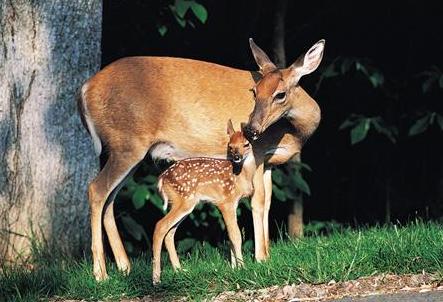All About Deer
We all love the sight of deer feeding out in a field, but the ability for deer to adapt to many types of environments has made them a pest to many of us. They are now protected, to a degree, by the government and for this reason deer populations have tripled since 1980 in the U.S.
Deer Habitat
 |
| Whether or not you're trying to encourage deer to visit your yard, or are actively chasing them away, everyone can enjoy a brief family visit. |
Deer prefer to live on the edge of forested area where they can receive shelter, food, and protection. Deer cannot eat mature trees and must have access to the forest floor where they can find new immature growth. Often, if you see families of deer more than once in your yard, it is the same family. Deer do not travel more than 2 square miles in a lifetime. Fall is their most active time.
Changing Seasons
Deer need different foods throughout the year. In spring they are hungry for protein. They consume many grasses, peas, and alfalfa. In the summer the deer craves leaves from trees, legumes, corn, and strawberries. In the fall, deer lean toward grains, berries, fallen leaves, acorns, and more evergreens. Winter is the most difficult season for the deer to find food and they will eat dead twigs, evergreens, and fallen leaves. To help them out, and help attract them to your yard in all seasons, put out some Critter Crunch, Whole Corn, or Cracked Corn. They will definitely appreciate it!
Attracting Deer
Create a dense thicket of trees and shrubs of native plants such as viburnum, dogwood, and elderberry, which can create a protective area. Birdbaths are also used by deer for water. Put out some feed (i.e. the Critter Crunch, Whole Corn, or Cracked Corn as mentioned above). Place food on a flat screen for easy feeding. Salt licks are good because deer seek out salt deposits through the year.
Discouraging Deer
Plant varieties that deer do not prefer include allium, foxglove, barberry, and ash. There are more plants than this, but it is best to contact us directly for a more complete list if you are having major problems with them. Line the deer entryway to your garden with plants that they do not like and leave the plants that you and the deer enjoy well within your garden. Hide all their favorite plants from view with a hedge screen that they do not prefer. Keep all wild grassy areas trimmed and cleaned to deter deer from bedding down. Place deer feeders with their favorite mixes and salts close to the entrance of your garden and they will have no need to go any further.
Protection and Chemical Deterrents
There is no one sure way to deter deer forever. It is often best to use more than one technique to ensure adequate protection through all the seasons.
Protecting your trees by wrapping them with plastic tubes or burlap can be very effective. Starting deterrents in the spring when deer are active is best. Deer walk into the wind so that they can smell what is ahead of them. Place deterrents in many areas of your garden to accommodate different wind directions. Products like Liquid Fence and Repels All work great and are safe for you, your children, and your pets. Predator urine is another good deterrent for deer. Bobcat and coyote are the natural enemies of deer and they will have a fear reaction to the urine.The best way to deter deer is to use many different types of deterrents, rotate them throughout the seasons and change them often before deer get wise to them.
Note: Preventing deer damage before it starts is easier than interrupting an established pattern!
